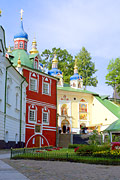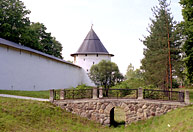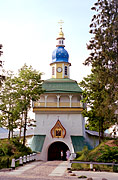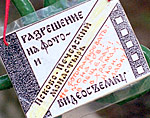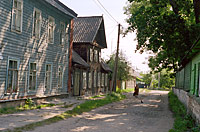History of Pechorskiy Monastery
The monastery was founded by presbyter Ioann in 1472. Ioann was a religious refugee from Derpt city. In 1473 he dig out the cave church of Our Lady (Uspenskaya Church) in the sand bluff of Kamenetz creek ravine near to the ancient "Holy Caves". That caves were well known mystic place among the local people, where angelic singing and voices were heard often.
Presbyter Misail was the next head of the monastery after Ioann death. The wooden cells and church were built on the bluff above the first church in that times. But all monastery buildings were burnt by Livonians in the end of 1480-th.
In 1519 all lands of Pskov's Republic were seized by Moscow. Deacon Misjur Menukhin from Pskov city was sent to Pechory by Moscow czar for inspecting of the monastery. Uspenskaya Church was reconstructed to Uspenskij (Assamption) Cathedral and new monastery buildings were erected in the Kamenetz ravine. First fortifications were also invented. Old Holy Caves were expanded and turned to monastery cemetery. The monastery become well known holy place of the area.
January 1558 the wasting Livonian War begun and lasted 25 years. In 1558 building new monasteries fortifications was initiated by czar Ivan the Terrible.
Abbot Kornilij was the Father superior of Pechorskij Monastery in that times. He was in favor of Ivan the Terrible till the Novgorod and Pskov city's smashing in 1570, when Kornilij has been killed in front of the Holy Gates of Pechorskij Monastery by czar himself.
In 1581, in the end of Livonian War, there were two fierce storms of Magyars and Pols from Stefan Batorij army. Attackers breached the walls by guns but could not succeed and were beaten off.
In 1592 during Russian-Sweden war of 1590-95 a little band of Swedes seized the fortress by bold night raid. They rushed inside of monastery, killed several soldiers and monks, stripped few monastery buildings and save theirs bacon early morning next day.
The fortress installations were in disrepair condition in the beginning of 17 AC. In 1638 big reconstruction began in Pechorskij monastery. The entrance to the fortress was rebuilt substantially. New gate's tower Petrovskaya was erected near to old Nikolskaya Church.
New earthen fortifications were constructed in the Pechorskaya fortress in the beginning of the Northern War by the order of czar Peter the Great. Five bastions near the towers, ditch and earthen battery in front of Nikolskaya Church were erected. The fortress bore Swedes storm in 1703.
The monastery began lost its military value after the Northern War end in 1721, but gain its value as spiritual and religious center. In 18 and especially 19 AC it was well known and all honoured holy place of North-West Russia.
After the February Revolution in 1917 the Time of Troubles and bloody Civil War begun in Russia. Pechory city - changed hands several times and was seized by Estonian from 1-st infantry at least in March 1920. The monastery and Pechory city was in the Estonia state under the terms of Tartu peace treatment of 1920.
In the end 1920-th comprehensive repair works were held in the Pechorskij monastery.
May, 22, 1940 Estonia was occupied, and Soviet Power was established. The monastery was renamed to "Uspenskaya Labor Commune". Father Superior of the monastery bishop Ioann was arrested by NKVD ("Narkomat Vnutrennikh Del" - Home Office in Soviet Union) and executed summer 1941 in Leningrad after short formal trial.
June 22, 1941 German troops crossed new Soviet border and invaded the country. July 8 Pechory area with the monastery was seized by Germans. During the occupation the monastery tried to help poor inhabitants of Pskov and Russian prisoners of POW camp N134 by food, clothing and other supply. Soviet scouts and partisans hid in the Holy Caves of the monastery, by some reports.
There were several hard bombing by Soviet aviation, spring 1944. The monastery treasure was hurried away to Riga by Germans. Pechory's monks decided to stay in the monastery and not evacuated with retreated Germans troops. August 11 Soviet troops entered the Pechory city under the Pechory monastery's bells peal.
Father Superior of the monastery wartimes Pavel was arrested October 1944 and condemned to 15 years labor camps under #58 clause of Criminal Code. He died in 1950 in Siberia. In 1997 public prosecutor's office of Pskov city revised his case and discharged all accusations.
There were some attempts of Soviet Power to abolish the monastery early 1960-th, but that attempts failed because of strong resistance of Father Superior Alipij. In 1973 monastery treasure was returned to the monastery from Germany and in 1991 ancient books were send back to the monastery from library of University of Tartu.
Some impressions
Impressions are "glamour". There are no choppy walls, cracked domes, thistle paths and all the same romantic breakups as in many other Russian historic places. If you hunting decline and fall, you'll need to search other places. The monastery was in bourgeois Estonia during the anti-religious persecution of 1930-th in Russia. It is beautiful, bright and shining. And very peculiar. One of disappointments is the objection to go to some place. It's no go - this is a monastery.
Land forts and fortress:
Bip Castle Gatchina Ivangorod Izborsk Kexholm Kirillov Monastery Koporye Novgorod Pechorskiy Monastery Peter&Paul Fortress Porkhov Pskov Schlisselburg Staraya Ladoga Tikhvin Vyborg Hameenlinna Hamina Kastelholm Kymenlinna Lappaenranta Raseborg Castle Savonlinna Tavetti Turku Visby Fredrikstadt Fredriksten Hegra Fort Hoytorp Fort Arensburg Narva Tallinn Antipatris Caesarea Jerusalem Latrun Fort Masada
Sea forts and fortresses:
Alexander Fort Ino Fort Krasnaya Gorka Fort Kronstadt: Kotlin isl. Kronstadt: North Forts Kronstadt: South Forts Trongsund Hanko Svartholm Sveaborg Marstrand Siaro Fort Vaxholm Oscarsborg
Artillery batteries and individual guns:
Coastal Artillery Hemso Fort
Fortified areas and defensive lines:
Karelian Fortified Area (KaUR) KrUR Leningrad Mannerheim Line Nevsky Bridgehead VT Line Harparskog Line Salpa Line Gothland
Russian
S e a r c h All news


